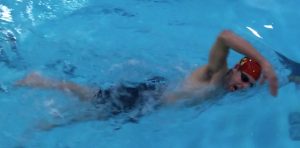 Breathing when swimming Freestyle is a necessity! Although it’s not always easy, developing comfort and learning to breathe effectively without losing speed is a skill that requires attention and practice. Here are four tips to help any triathlon or competitive swimmer develop and maintain excellent breathing habits.
Breathing when swimming Freestyle is a necessity! Although it’s not always easy, developing comfort and learning to breathe effectively without losing speed is a skill that requires attention and practice. Here are four tips to help any triathlon or competitive swimmer develop and maintain excellent breathing habits.
Pick 1 Side
While bilateral breathing is important, it is often easier to progress when getting comfortable with rotary breathing by choosing 1 side to start. The timing of your rotation, balance, and breath are all challenged every stroke cycle. By choosing 1 side, you are able to appropriately repeat/make adjustments to the elements that go into your breath, and improve more rapidly! Once you are comfortable breathing to 1 side (where you do not need to consciously think about the steps required to get a good breath of air while swimming), then it is a good time to start challenging your opposite side. Until that point, stick to 1 side and accelerate your progress!
Breathe Early
Simply put, breathing early helps you maintain your pull timing and balance, while also providing you with more time to take a breath! Ideally, swimmers want to initiate the breath as soon as they begin to pull with their “same side” arm; ie if breathing to the right, start the breath when the right arm begins to pull. If breathing to the left, begin the breath when the left arm begins to pull. When it comes to Freestyle breathing, the earlier, the better!
Stay Low
Anytime a swimmer breathes, they roll to their must unbalanced position, when can compromise speed. By staying low in the water, you are ensuring that your body line stays tall, you are maintaining proper balance, thus not slowing down! The visual we use at Excel Aquatics is ‘single goggle breathing’. This means when a swimmer takes a breath, their lower goggle should be close to/just under the surface of the water, while their upper goggle should be just over the surface of the water. When executed properly, ‘single goggle’ breathing helps promote proper body line when taking the breath.
Take Your Time
Take your time: similar to point #2, the more time a swimmer has to breathe, the better. This also means that too fast of a stroke rate can limit oxygen intake significantly, especially over longer distances! When practicing breathing, be sure to have a long, relaxed stroke to give yourself ample time to not only turn your head, but get a full breath of air.
Interested in learning more about Freestyle swim training and technical tips for triathletes? Check out Excel Aquatics’ YouTube channel. New videos are posted every Tuesday and Thursday!
